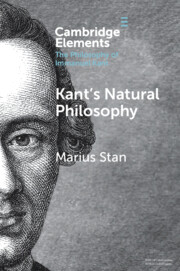Refine search
Actions for selected content:
27 results

Kant’s Natural Philosophy
-
- Published online:
- 04 August 2025
- Print publication:
- 21 August 2025
-
- Element
- Export citation
1 - Some Problems of Induction
- from Part I - Background and Basic Concepts
-
- Book:
- An Introduction to the Philosophy of Science
- Published online:
- 29 March 2025
- Print publication:
- 27 March 2025, pp 3-14
-
- Chapter
- Export citation
Chapter 13 - Number Crunching
- from Part III - Mathematical Theories
-
- Book:
- Looking Ahead
- Published online:
- 20 March 2025
- Print publication:
- 06 March 2025, pp 139-145
-
- Chapter
- Export citation
9 - The Objectifying Gaze of Science and Technology in the Political Context
- from Part III - The Dialectics of Objectification
-
- Book:
- Can Democracy Recover?
- Published online:
- 02 January 2025
- Print publication:
- 16 January 2025, pp 93-99
-
- Chapter
- Export citation
God’s Timelessness, Our Temporal Nature
-
- Journal:
- Journal of Anglican Studies / Volume 22 / Issue 2 / November 2024
- Published online by Cambridge University Press:
- 13 January 2025, pp. 529-541
-
- Article
- Export citation
Chapter 8 - Hegel’s Mechanics as a System of Steps from Space and Time to Celestial Motion
- from Part II - Cosmology, Mechanics, and Physics
-
-
- Book:
- Hegel's <i>Philosophy of Nature</i>
- Published online:
- 19 December 2024
- Print publication:
- 12 December 2024, pp 158-175
-
- Chapter
- Export citation
Chapter 23 - Colour Theory
- from Part IV - Philosophy and Science
-
-
- Book:
- Goethe in Context
- Published online:
- 16 May 2024
- Print publication:
- 23 May 2024, pp 225-233
-
- Chapter
- Export citation
Chapter 4 - The Cyclops (Cyclops inhospitalis)
-
- Book:
- The Trojan Horse and Other Stories
- Published online:
- 09 November 2023
- Print publication:
- 11 January 2024, pp 85-108
-
- Chapter
- Export citation
7 - Emergence of Modern Science
- from Part I - Psychology’s Historical Foundations
-
- Book:
- History and Systems of Psychology
- Published online:
- 04 November 2022
- Print publication:
- 17 November 2022, pp 127-146
-
- Chapter
- Export citation
Precise Limb Tourniquet Arterial Occlusion Pressure Determination using Real-Time Ultrasonography and a Capacitive-Based Force Sensor
-
- Journal:
- Prehospital and Disaster Medicine / Volume 37 / Issue 6 / December 2022
- Published online by Cambridge University Press:
- 18 October 2022, pp. 772-777
- Print publication:
- December 2022
-
- Article
- Export citation
Chapter 3 - Modern Science Contra Classical Philosophy
-
- Book:
- Charles Peirce and Modern Science
- Published online:
- 26 October 2022
- Print publication:
- 15 September 2022, pp 39-64
-
- Chapter
- Export citation
Chapter 1 - Mechanisms, Then and Now
- from Part I - Ideas of Mechanism
-
- Book:
- Mechanisms in Science
- Published online:
- 09 June 2022
- Print publication:
- 23 June 2022, pp 15-39
-
- Chapter
- Export citation
10 - Concluding Remarks
- from Part II - Kant’s Theory of Magnitudes, Intuition, and Measurement
-
- Book:
- Kant's Mathematical World
- Published online:
- 21 October 2021
- Print publication:
- 28 October 2021, pp 281-285
-
- Chapter
- Export citation
4 - Science, Vision, Perspective
-
-
- Book:
- Vision
- Published online:
- 17 September 2021
- Print publication:
- 26 August 2021, pp 107-130
-
- Chapter
- Export citation
Scientific Ontology: Fact or Stance?
-
- Journal:
- Dialogue: Canadian Philosophical Review / Revue canadienne de philosophie / Volume 60 / Issue 1 / April 2021
- Published online by Cambridge University Press:
- 27 July 2021, pp. 15-31
-
- Article
-
- You have access
- Open access
- HTML
- Export citation
Chapter 1 - Gravitational Physics
- from Part I - Space and Time in Newtonian Physics and Special Relativity
-
- Book:
- Gravity
- Published online:
- 03 September 2021
- Print publication:
- 24 June 2021, pp 3-12
-
- Chapter
- Export citation
6 - Manipulating Nature
-
- Book:
- Magic, Science, and Religion in Early Modern Europe
- Published online:
- 22 January 2021
- Print publication:
- 28 January 2021, pp 161-188
-
- Chapter
- Export citation
2 - Space
-
- Book:
- Space and Fates of International Law
- Published online:
- 20 August 2020
- Print publication:
- 17 September 2020, pp 26-56
-
- Chapter
- Export citation
Chapter 5 - Ecumenical Poetics: William Cowper
-
- Book:
- Godless Fictions in the Eighteenth Century
- Published online:
- 06 August 2020
- Print publication:
- 09 July 2020, pp 170-202
-
- Chapter
- Export citation
4 - Newton and the Law of Gravity
- from Case Study I - The Origins of Newton’s Laws of Motion and of Gravity
-
- Book:
- Theoretical Concepts in Physics
- Published online:
- 27 March 2020
- Print publication:
- 16 April 2020, pp 48-72
-
- Chapter
- Export citation
